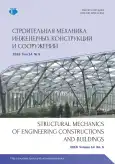Accounting for the filling of the reservoir when calculating the stress-strain state of a concrete dam
- Авторлар: Baklykov I.V1
-
Мекемелер:
- JSC “Institute Hydroproject”
- Шығарылым: Том 14, № 5 (2018)
- Беттер: 390-395
- Бөлім: Analysis and design of building structures
- URL: https://journal-vniispk.ru/1815-5235/article/view/346336
- DOI: https://doi.org/10.22363/1815-5235-2018-14-5-390-395
- ID: 346336
Дәйексөз келтіру
Толық мәтін
Аннотация
The aim of work. The paper considers the issue of reservoir accounting when calculating the stress-strain state of a concrete dam and its foundation. Solution technique. As a rule, reservoirs on a global scale represent a large gravitational mass in the form of water, which affects the engineering-geological situation in a large deep of rocks foundation. To study this factor, an investigation was made of the power component of the reservoir on the basis of the “reservoir - structure - rock foundation” system. For the calculations, the hydro power plant of Boguchanskaya HPP was selected, which is part of the Angara river cascade and is located in Siberia. To perform the stress-strain state calculations, a three-dimensional mathematical finite element model of the “reservoir - structure - rock foundation” system was created on the basis of which the predicted values of the calculated draft of the concrete dam are determined. The mathematical model consists of a fragment of the rock foundation, represented by the lithosphere and the upper part of the asthenosphere. To verify the proposed reservoir account, the predicted sediment values were compared with geodesic data, while the comparison results showed a high degree of correlation. A high degree of correlation suggests that the proposed method predicts the rock foundation and structure sediments quite well when filling the reservoir. Results. The results of the conducted investigations and comparisons of calculated and field data have shown the necessity of reservoir accounting when calculating predictions of sediment values of hydraulic structures and their rock foundation. This forecast is quite important in determining the criterial values of diagnostic indicators for the safety control of the structure.
Негізгі сөздер
Авторлар туралы
Igor Baklykov
JSC “Institute Hydroproject”
Хат алмасуға жауапты Автор.
Email: moscow_igor88@mail.ru
Leading Engineer of the JSC “Institute Hydroproject”
2 Volokolamskoe Shosse, Moscow, 125080, Russian FederationӘдебиет тізімі
- Savich A.I., Gaziev Eh.G. (2005). Vliyanie vodohranilishch na povedenie skal'nyh massivov osnovanij vysokih plotin [Influence of reservoirs on the behavior of rock massifs in the foundations of high dams]. Gidrotekhnicheskoe stroitel'stvo [Hydrotechnical construction], (11), 33–37. (In Russ.)
- Tetel'min V.V., Ulyashinskij V.A. (1990). Tekhnogennye vozdejstviya i processy v skal'nyh osnovaniyah plotin [Man-caused impacts and processes in rock bases of dams]. Moscow: Ehnergoatomizdat publ., 160. (In Russ.)
- Balavaze B.K., Abashidze V.G. (1985). Naklony i deformacii zemnoj kory v rajone Ingurskoj GEHS [The slopes and deformations of the earth's crust in the region of the Inguri hydroelectric power station]. Tbilisi: Mecniereba publ., 117. (In Russ.)
- Savich A.I., Il'in M.M. (2003). Osobennosti vliyaniya vodohranilishch na skal'nye osnovaniya bol'shih plotin [Features of the influence of reservoirs on the rock bases of large dams]. Gidrotekhnicheskoe stroitel'stvo [Hydrotechnical construction], (3), 48–53. (In Russ.)
- Tetel'min V.V., Baklykov I.V. (2017). Glubinnye processy massoi teploperenosa v osnovaniyah vysokih plotin [Deep processes of mass and heat transfer in the foundations of high dams]. Izvestiya VNIIG, 283. (In Russ.)
- Zoback M.D. (2010). Reservoir Geomechanics. Cambridge University Press, 461.
- Abakarov A.R., Durcheva V.N. (2004). Sostoyanie Chirkejskogo gidrouzla po dannym mnogoletnih kompleksnyh naturnyh nablyudenij [The state of the Chirkei hydroelectric complex according to the data of long-term complex natural observations]. Gidrotekhnicheskoe stroitel'stvo [Hydrotechnical construction], (9), 43–51. (In Russ.)
- Durcheva V.N., Puchkova S.M. (2006). Rabota plotiny Burejskoj GEHS pri napolnenii vodohranilishcha [The work of the dam at the Bureyskaya HPP during the filling of the reservoir], Gidrotekhnicheskoe stroitel'stvo [Hydrotechnical construction], (1), 8–15. (In Russ.)
- Marchuk A.N., Marchuk N.A. (2010). Tektonofizicheskie aspekty napryazhyonno-deformirovannogo sostoyaniya bol'shih betonnyh plotin [Tectonophysical aspects of the stressstrain state of large concrete dams], Gidrotekhnicheskoe stroitel'stvo [Hydrotechnical construction], (3), 31–34. (In Russ.)
- Jay N. (2016). Stateler, Brad Iarossi Using monitoring programmes to manage dam safety risks. Hydropower and dams, (4), 90–96.
- Brouillac P., Carreaud P. (2015). New approaches for improved dam monitoring. Hydropower and dams, (3), 70–75.
- Volynchikov A.N., Mgalobelov Y.B., Baklykov I.V. (2015). Connecting of the concrete and rock-fill dams at the Boguchanskaya HPP, Power Technology and Engineering, 48(6), 431–438.
- Lisichkin S.E., Rubin O.D., Shakars I.Eh., Novikov S.P. (1998). Raschyotnaya ocenka napryazhyonnodeformirovannogo sostoyaniya levogo bloka zdaniya Plyavin'skoj GEHS s uchyotom dannyh naturnyh nablyudenij [A computational estimate of the stress-strain state of the left block of the Plavinskaya HPP building, taking into account the field observations], Gidrotekhnicheskoe stroitel'stvo [Hydrotechnical construction], (2), 47–53. (In Russ.)
- Rubin O.D., Lisichkin S.E., Grebenshchikov V.P., Cybakov V.A., Nefyodov A.V., Katanov A.D., Ponomaryov D.I. (2005). Raschyotnoe obosnovanie reshenij po obespecheniyu nadyozhnosti konstrukcij vodosbrosa № 2 betonnoj plotiny Boguchanskoj GEHS [Calculation justification of the decisions to ensure the reliability of the spillways design of No. 2 concrete dam of the Boguchanskaya HPP]. Izvestiya VNIIG [Proceedings of the VNIIG], 244, 227–233. (In Russ.)
- Rubin O.D., Lisichkin S.E., Lyapin O.B., Nefedov A.V. (1999). Issledovaniya betonnyh i zhelezobetonnyh ehnergeticheskih sooruzhenij [Investigations of concrete and jelly-zibeton energy facilities], Gidrotekhnicheskoe stroitel'stvo [Hydrotechnical construction], (8/9), 22–28. (In Russ.)
- Kozinec G.L. (2014). Matematicheskoe prostranstvennoe modelirovanie gidroagregatnyh blokov vysokonapornyh GEHS [Mathematical spatial modeling of hydrounit blocks of high-pressure hydroelectric power stations], Gidrotekhnicheskoe stroitel'stvo [Hydrotechnical construction], (11), 22–25. (In Russ.)
- Glubinnoe stroenie slabosejsmichnyh regionov SSSR [Deep structure of the weakly seismic regions of the USS]. (1987). Moscow: Nauka publ., 238. (In Russ.)
Қосымша файлдар









